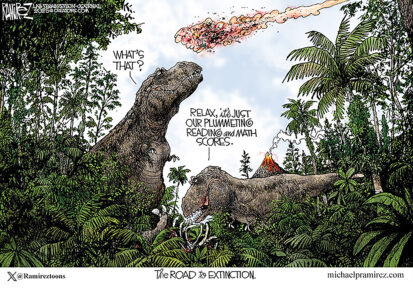Advice on handling aggressive driving
Road rage apparently is contagious, according to AAA.
Exposure to aggressive driving fuels more aggression behind the wheel, research from the AAA Foundation for Traffic Safety showed. In a survey of licensed drivers, 96% admitted to at least one aggressive driving behavior in the past year, including red-light running, speeding, tailgating, honking or cutting off other vehicles.
The study reveals a self-perpetuating cycle: the more drivers encounter hostility on the road, the more likely they are to respond in kind and escalate tensions behind the wheel, AAA states in a news release.
“Driving often turns into a high-stress experience, not just because others drive recklessly but because we react in the moment,” said Adrienne Woodland, spokeswoman for AAA – The Auto Club Group. “Our research shows that even the calmest drivers can get drawn into road rage after a single hostile encounter, but with simple strategies we can all help make roads safer.”
Some key findings include —
— Aggressive driving: Among the 96% of drivers who admitted to driving aggressively in the past year, their top motivators were to get to their destination faster and avoid perceived danger.
— Violent actions: 11% admitted to engaging in violent actions, such as intentionally bumping into another car or confronting another driver.
— Top offenders: Motorists younger than age 60 and those with household incomes of $100,000 or more. While men and women are equally likely to drive aggressively, men are significantly more prone to escalating into violent driving behaviors.
— Aggression breeds aggression: The more drivers are exposed to aggressive behavior on the road, the more likely they are to drive aggressively themselves.
— The vehicle plays a role: The kind of car you drive could predict how you act and how others perceive you. Drivers in sports cars, big trucks and motorcycles are often seen as more aggressive. Some drivers say they felt more powerful and dominant behind the wheel of these vehicles.
This latest study updates research originally conducted by the AAA Foundation for Traffic Safety in 2016, offering a look at how aggressive driving behaviors have shifted over time. While some behaviors have become more common, others have declined, AAA stated.
Since 2016 —
— Cutting off other vehicles is up 67%;
— Honking out of anger is up 47%; and
— On the positive side, tailgating is down 24% and yelling at other drivers is down 17%.
In its release, AAA encouraged drivers to prioritize courtesy and safety to help curb aggressive driving.
“Good road etiquette and being courteous to other drivers are the most effective ways to reduce aggressive driving and road rage,” Woodland said. “Small gestures like using turn signals, letting others merge, and offering a friendly wave can go a long way in creating a calmer driving environment for everyone.”
In an encounter with an aggressive driver, AAA advises —
— Stay calm: Avoid eye contact, gestures or responding.
— Give space: Let them pass and keep your distance.
— Protect yourself: If being followed, call 911 or go to a public place. Never drive home!
How to control road rage —
— Breathe before you react: One deep breath can reset your drive.
— Don’t take the bait: Ignore and avoid aggressive drivers.
— Choose time over tension: Leave early, give space.



